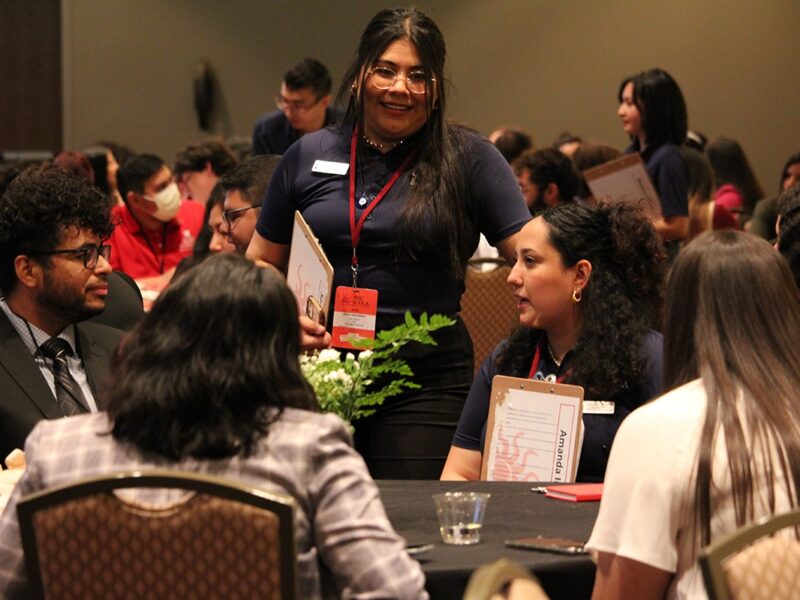Closing The Educational Achievement Gap For English Language Learners
Closing the educational achievement gap for children who are learning English as a second language is the focus for researchers in Texas A&M University’s new Center for Research and Development in Dual Language and Literacy Acquisition (CRDLLA).
In Texas alone, more than 809,000 students were served in English language learner (ELL) programs in 2011-2012, according to the Texas Education Agency. Nationally, nearly 11.2 million school-aged children and their families are non-English speakers and 73 percent are Spanish speakers. Dropout rates among Hispanics/Latinos are a major concern and are reported to be the highest among all ethnic groups, according to the National Center for Education Statistics.
The CRDLLA was approved in August as an official university center by the Texas A&M University System Board of Regents, announced Dean Douglas Palmer of the College of Education and Human Development (CEHD). “High-quality research and training activities are essential to ensure success in school for English language learners,” said Palmer. “The CRDLLA will focus on professional development and research activities to help address some of the most urgent state and national educational needs and challenges,” he said.
Led by co-directors Rafael Lara-Alecio and Beverly J. Irby, and associate director, Fuhui Tong, the center will provide leadership in research, assessment, professional development and outreach to enhance the academic success of second language learners through programs that promote dual language and English language and literacy acquisition. CRDLLA will involve faculty across the CEHD and the university, as well as national and international scholars from varied disciplines.
Lara-Alecio said he wants to ensure that ELLs experience the same academic achievement and success in school as their mainstream peers. “About 16 percent of children attending schools in America come from homes where English is not the primary language,” said Lara-Alecio. “The CDRLLA research will help determine the best approaches, methodologies and techniques to better prepare teachers to educate ELLs.”
“Ongoing observation and feedback to teachers is critical to improve ELLs’ educational outcomes. Therefore, we systematically observe educational practices of teachers and the cognitive demands they present to students,” said Irby.
They can observe whether a teacher is eliciting only social or academic routines, if there are significant numbers of non-academic interruptions during class time, or whether students are able to go deep into the subject matter necessary for content area comprehension. “We also can observe the activity structures in the classroom, such as teacher lectures and demonstrations and, for example, whether the students are listening and performing as expected,” noted Irby.
CRDLLA will promote practical classroom observations, which are based on the only theoretical framework for observing bilingual classroom teaching methods, developed and published by professors Lara-Alecio and Richard Parker at Texas A&M in 1994.

This four-dimension education and instruction theory, and accompanying observation instrument, is used to observe communication modes of listening, speaking, writing and reading by language, language of instruction, language content and classroom activity structures. “Through this instrument, we have the opportunity to monitor quality instruction in a reliable and valid way,” said Lara-Alecio.
What Works
A $16.5 million award by the Office of Innovation and Improvement, U.S. Department of Education, provides the major funding for project English Language and Literacy Acquisition-Validation (ELLA-V). ELLA-V is the only ongoing, national validation study that is a randomized, control study for the improvement of education for ELLs.
Tong oversees the data collection process and is partnering with a team at Johns Hopkins University to provide the statistical analyses and results as one component of the evaluation process of ELLA-V.
“Right now, four of our publications have been identified through a rigorous review process and will be included in the What Works Clearinghouse (WWC),” said Tong. The WWC is an initiative of the U.S. Department of Education’s Institute of Education Sciences and publishes proven scientific information on what works in education to improve student outcomes.
“Three of the publications originated from the results of our other nationally-funded projects related to English language and literacy acquisition,” she said. Funding for those studies came from the Institute of Education Sciences and the National Science Foundation (NSF).
Based on those studies, the CRDLLA research team found that early success in academics forms the foundation for later success and higher scores in content specific areas, such as science.
Currently, the CRDLLA is working with seven school districts across Texas, targeting those with large populations of Spanish-speaking students. They include Houston, Aldine, Spring Branch, Brownsville, Donna, Laredo and United ISDs.
“We will be adding other school districts and expanding our online professional development opportunities for administrators and teachers through a partnership with Citrix Go-To-Meeting,” said Irby. “The center will also conduct a variety of studies including longitudinal studies, intervention studies, and studies of academic reading and writing or vocabulary development and content area instruction, particularly in the area of science,” she said.
Additionally, the CRDLLA is working to include research on other language learners such as native Mandarin speakers who are learning English.
Ultimately, the CRDLLA is a reflection of Texas A&M’s mission as a land-grant institution and officials expect it to impact educational and academic practice and policy at the state, national and international levels.
Media contact: tamunews@tamu.edu.





